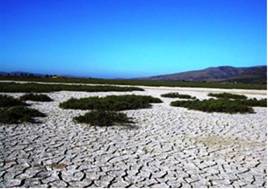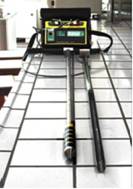Electrical conductivity
Salt content of the soil can be assessed by measuring the electrical conductivity in a saturated soil paste. Salinization is a major process that causes salt accumulation in soils and it is related to climate, physiography, and irrigation. The climate acts directly through high evaporation rates, and indirectly as the driving force behind soil salinization associated with irrigation. A distinction can be made between primary and secondary Salinization processes. Primary salinization involves accumulation of salts through natural processes such as physical and chemical weathering and transport processes from salty geological deposits or groundwater. Secondary Salinization is caused by human interventions such as inappropriate irrigation practices, use of salt-rich irrigation water and/or poor drainage conditions.
Electrical conductivity (EC) in the study field sites has been measured directly in the field using an electrical conductivity-probe set (Fig. 32) for salinity measurements or in the laboratory on a saturated paste. The following classes of soil electrical conductivity have been used for the DESIRE project: (a) free of salts, EC< 2 dS m-1; (b) slightly affected soils, EC = 2 to 4 dS m-1; (c) moderately affected soils, EC = 4 to 8 dS m-1; (d) highly affected soils, EC = 8-15 dS m-1; and (e) very highly affected soils, EC>15 dS m-1.


Fig. 32. Soil with high electrical conductivity (left) due to high salt concentration and an electrical conductivity-probe used for measuring it (right)
Soil electrical conductivity has been measured in 258 field sites, corresponding to the 5 following study sites (Table 3): Nestos Basin Maggana-Greece, Boteti Area-Botswana, Secano Interior-Chile, Mamora Sehoul-Morocco, Novij Saratov-Russia, Djanybek-Russia, and Crete-Greece. As Fig. 33 shows, the majority of the study field sites (53.5%) had a moderate (4-8 dS m-1) soil electrical conductivity corresponding to all above mentioned study sites except for Boteti Area-Botswana. Highly salt affected soils with an electrical conductivity (8-15 dS m-1) have been found in 22.9% of the study field sites. Such values of electrical conductivity have been measured in all the above mentioned study sites. Slightly affected soils have been found in 14.7% of the study field sites, corresponding to the above study sites except for Djanybek-Russia, and Boteti Area-Botswana sites. Soils free of salts have been found in 5% of the study field sites located in the study sites of Greece. Very highly salt affected soils have been found in few cases (3.9% of the study field sites) in Nestos Basin Maggana-Greece, and Boteti Area-Botswana sites.

Fig. 33. Distribution of soil electrical conductivity classes measured in the various study field sites